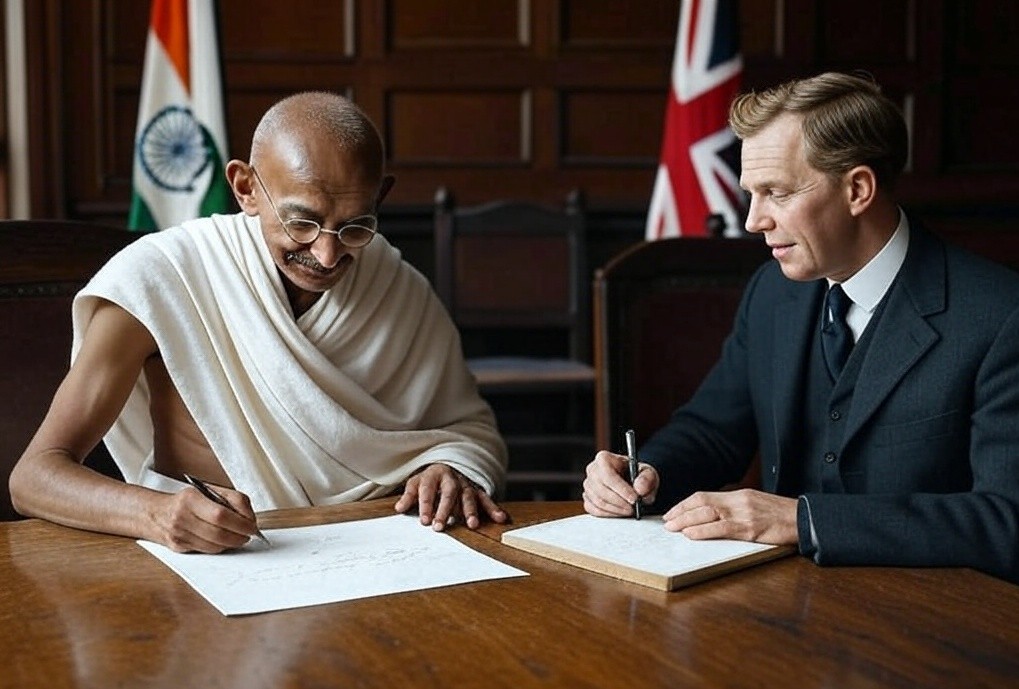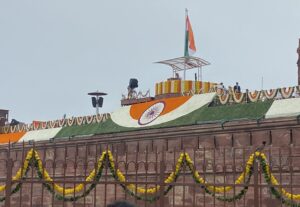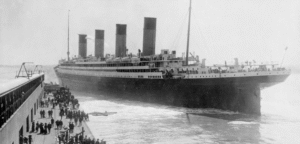The Gandhi-Irwin Pact, also known as the Delhi Pact, was a significant agreement signed on March 5, 1931, between Mahatma Gandhi, representing the Indian National Congress, and Lord Irwin, the Viceroy of India, on behalf of the British colonial government. The pact marked a temporary truce in the Indian independence movement, particularly following the Civil Disobedience Movement and the Salt Satyagraha. Below are the complete details of the pact, including its background, terms, significance, and aftermath.
Background
- Civil Disobedience Movement (1930):
- The Indian National Congress, under Gandhi’s leadership, launched the Civil Disobedience Movement in 1930 to challenge British authority.
- A key event was the Salt March (March 12–April 6, 1930), where Gandhi and his followers marched 240 miles from Sabarmati Ashram to Dandi to produce salt, defying the British salt monopoly and tax.
- The movement gained widespread support, with millions participating in acts of nonviolent resistance, such as boycotting British goods, picketing liquor shops, and refusing to pay taxes.
- The British responded with mass arrests, imprisoning over 60,000 Indians, including Gandhi, who was arrested on May 5, 1930.
- Growing International and Domestic Pressure:
- The Salt Satyagraha drew global attention to India’s struggle, embarrassing the British government.
- Within India, the movement disrupted colonial administration, as peasants, workers, and urban populations joined the protests.
- The British government, under pressure to stabilize the situation, sought a way to negotiate with the Congress.\
- First Round Table Conference (1930):
- The British organized the First Round Table Conference in London to discuss constitutional reforms for India.
- The Congress boycotted the conference, demanding complete independence (Purna Swaraj), which weakened the conference’s legitimacy.
- The failure of the conference prompted the British to engage directly with Gandhi.
- Preliminary Talks:
- In early 1931, Lord Irwin initiated indirect talks with Gandhi through intermediaries like Tej Bahadur Sapru and M.R. Jayakar.
- Gandhi was released from jail on January 26, 1931, along with other Congress leaders, to facilitate negotiations.
Negotiations
- The negotiations between Gandhi and Lord Irwin took place over several meetings in February 1931 in Delhi.
- Gandhi insisted on addressing the grievances of the Indian people, particularly the repressive measures against the Civil Disobedience Movement.
- Lord Irwin aimed to secure Congress participation in the upcoming Second Round Table Conference and restore order in India.
- After intense discussions, the two sides reached a compromise, formalized as the Gandhi-Irwin Pact.
Terms of the Gandhi-Irwin Pact
The pact was a mutual agreement with concessions from both sides. Its key terms were:
Congress Commitments:
- Suspension of Civil Disobedience Movement:
- The Congress agreed to call off the Civil Disobedience Movement and related protests, including the boycott of British goods.
- Participation in Round Table Conference:
- The Congress agreed to participate in the Second Round Table Conference in London to discuss constitutional reforms for India.
- No Investigation into Police Conduct:
- The Congress agreed not to press for an inquiry into police excesses and brutalities committed during the suppression of the movement.
British Government Commitments:
- Release of Political Prisoners:
- The British agreed to release all political prisoners arrested during the Civil Disobedience Movement, except those convicted of violent crimes.
- Withdrawal of Repressive Ordinances:
- The government agreed to withdraw emergency ordinances issued to curb the movement, such as those restricting press freedom and public gatherings.
- Restoration of Confiscated Property:
- Properties confiscated from Congress supporters during the movement were to be returned, provided they were not sold to third parties.
- Permission for Peaceful Picketing:
- The British allowed peaceful picketing of liquor and foreign cloth shops, recognizing the Congress’s campaign against alcohol and imported goods.
- Salt Concession:
- The government permitted coastal residents to collect and manufacture salt for personal use without paying the salt tax, partially addressing the grievances raised during the Salt Satyagraha.
- Lifting Restrictions on Congress:
- Restrictions on the activities of the Indian National Congress were to be lifted.
Mutual Understanding:
- Both sides agreed to work toward restoring amicable relations and preventing further escalation of tensions.
- The pact did not explicitly address the demand for complete independence, which remained a point of contention.
Significance of the Gandhi-Irwin Pact
- Recognition of Congress:
- The pact was a diplomatic victory for the Congress, as it forced the British to negotiate with the organization as a legitimate representative of the Indian people.
- It elevated Gandhi’s stature as a national leader and the Congress’s role in the independence movement.
- Temporary Truce:
- The agreement provided a respite from the intense confrontation between the Congress and the British, allowing both sides to reassess their strategies.
- It created an atmosphere conducive to dialogue, leading to Congress participation in the Second Round Table Conference.
- Moral Victory for Nonviolence:
- The pact underscored the effectiveness of Gandhi’s nonviolent methods, as the British were compelled to negotiate without the Congress resorting to violence.
- It inspired further mass mobilization in the independence movement.
- Global Attention:
- The negotiations and the pact drew international focus to India’s struggle, increasing sympathy for the Indian cause in countries like the United States and Britain.
- Partial Concessions:
- While the pact did not grant complete independence, it secured practical concessions, such as the release of prisoners and the salt tax relaxation, which were seen as victories by many Indians.
Criticisms and Limitations
- Incomplete Demands:
- The pact did not address the Congress’s core demand for Purna Swaraj (complete independence), leading to dissatisfaction among some leaders.
- Critics, including younger and more radical Congress members like Jawaharlal Nehru and Subhas Chandra Bose, felt the pact compromised the movement’s momentum.
- Ambiguity in Implementation:
- The terms of the pact, such as the release of prisoners and return of confiscated property, were vaguely worded, leading to disputes over implementation.
- Many prisoners convicted of minor offenses were not released, and confiscated lands were often not returned.
- No Accountability for Police Excesses:
- The Congress’s agreement to forgo an inquiry into police brutalities was seen as a concession to the British, disappointing those who sought justice for victims of repression.
- Limited Scope of Salt Concession:
- The relaxation of the salt tax was restricted to coastal areas and did not fully dismantle the salt monopoly, limiting its impact.
- Temporary Nature:
- The pact was a short-term truce rather than a permanent solution, and tensions resurfaced when the Second Round Table Conference failed to produce meaningful reforms.
Aftermath
- Second Round Table Conference (1931):
- Gandhi represented the Congress at the Second Round Table Conference in London (September–December 1931).
- The conference failed to reach a consensus due to disagreements over issues like separate electorates for minorities and the lack of commitment to dominion status or independence.
- Gandhi returned to India disappointed, and the Congress resumed the Civil Disobedience Movement in January 1932.
- Resumption of Repression:
- The British, under the new Viceroy Lord Willingdon, adopted a hardline stance after the failure of the conference.
- Gandhi and other Congress leaders were rearrested, and the Civil Disobedience Movement was suppressed with greater force.
- Legacy:
- Despite its limitations, the Gandhi-Irwin Pact was a milestone in India’s independence struggle, demonstrating the power of nonviolent resistance and mass mobilization.
- It strengthened the Congress’s position as the leading voice of the Indian people and set the stage for future negotiations with the British.
- The pact highlighted the challenges of negotiating with a colonial power while maintaining unity within a diverse independence movement.
Key Figures
- Mahatma Gandhi: Leader of the Indian National Congress and architect of the Civil Disobedience Movement. His commitment to nonviolence and willingness to negotiate shaped the pact.
- Lord Irwin (Edward Wood): Viceroy of India (1926–1931), known for his relatively liberal approach compared to his successors. His decision to negotiate with Gandhi was a pragmatic move to stabilize British rule.
Conclusion
The Gandhi-Irwin Pact was a pivotal moment in India’s struggle for independence, symbolizing both the potential and the limitations of dialogue between the Indian National Congress and the British colonial government. While it achieved temporary concessions and showcased the effectiveness of nonviolent resistance, it fell short of addressing the ultimate goal of complete independence. The pact’s legacy lies in its demonstration of the Congress’s growing influence and the British government’s willingness to engage with Indian leaders, paving the way for future negotiations in the long road to India’s independence in 1947.















Leave a Reply